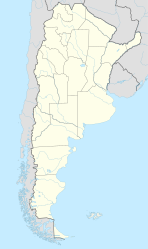Gualeguaychú, Entre Ríos
| Gualeguaychú | ||
|---|---|---|
| City | ||

Calle 25 de Mayo
|
||
|
||
| Location of Gualeguaychú in Argentina | ||
| Coordinates: 33°1′S 58°31′W / 33.017°S 58.517°WCoordinates: 33°1′S 58°31′W / 33.017°S 58.517°W | ||
| Country | Argentina | |
| Province | Entre Ríos | |
| Department | Gualeguaychú | |
| Founded | October 18, 1783 | |
| Founded by | Tomas de Rocamora | |
| Government | ||
| • Mayor | Martin Piaggio | |
| Elevation | 15 m (49 ft) | |
| Population (2010) | ||
| • Total | 102,421 | |
| Time zone | ART (UTC−03:00) | |
| ZIP Code | E2820 | |
| Dialing code | +54 3446 | |
| Website | Official website | |
Gualeguaychú is a city in the province of Entre Ríos, Argentina, on the left bank of the Gualeguaychú River (a tributary of the Uruguay River). It is located on the south-east of the province, approximately 230 km north-west of Buenos Aires. It has a population of 109,266 according to the .
The city is located near national route 14, a route growing in importance because it connects Argentina's capital Buenos Aires and São Paulo in Brazil, the biggest city of South America, being one of the most important routes in Mercosur.
The city hosts an annual carnival that is regionally well-known and attended by people from many other provinces and countries around the world. It is considered one of the largest carnivals in the world. Gualeguaychú also has hot springs, beach resorts, and a casino.
Near Gualeguaychú is Pueblo Belgrano, a municipality that belongs to the city, which is well known for its hot springs. Gualeguaychú should not be confused with Gualeguay, another city also in Entre Ríos, located about 80 km (50 mi) west.
The city took the name of the river that is next to it, Gualeguaychú. According to records from 1715 made by the priest Polycarp Dufoo, the name comes from the Guaraní expression, "yaguarí guazú", which would mean "big-water river".
According to scholars of toponomy, there are other definitions such as "Slow-go Water" or "River of the Small Pig Caves" (with pig meaning capybara) the latter by the similarity to the word Gualeguay.
The land has been inhabited since pre-Hispanic times by Chaná, Charrúa. From the 17th century, Spanish representatives from Santa Fe and Buenos Aires gave possession of these lands to settlers who founded precarious rural settlements in constant dispute with the native tribes. These conflicts resulted in series of campaigns and extermination and enslavement of the natives, who had been decimated by the mid-eighteenth century. In the final decades of the century, the number of people scattered throughout the area from Buenos Aires and Santa Fe, including Jesuit missionaries, increased. These inhabitants developed a subsistence economy and had conflicts with landowner settlers, who had already been settled there for decades.
...
Wikipedia


